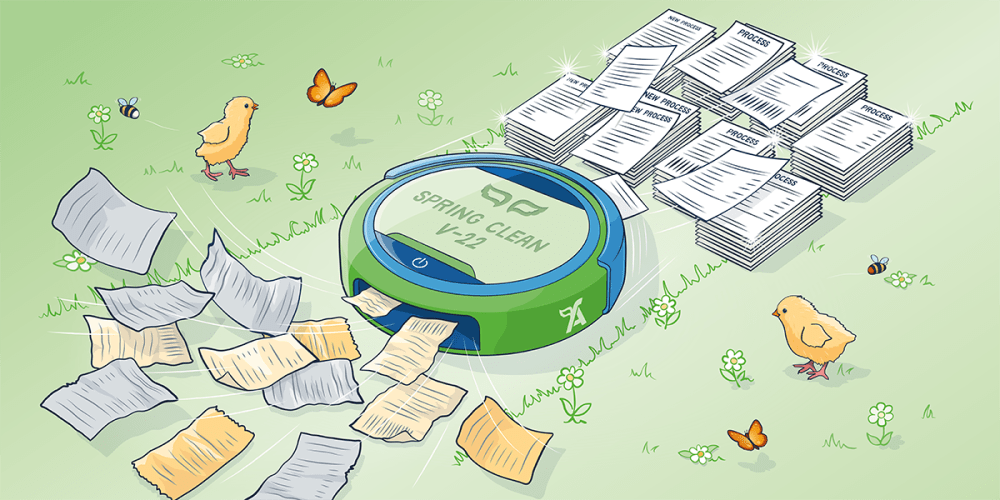How to spring-clean your practice processes

Spring isn’t just a time for sweeping away cobwebs and cleaning at home. It can also be an ideal time for accountants and bookkeepers to look at their practice processes, peek under the rug, find the dust bunnies and make sure everything is working as efficiently as possible before moving into a new tax year. In our recent webinar, half of participants said that they review their processes every year and 29% review more than once a year. Here are some key areas to look at, alongside insight from practices.
Improve your onboarding
It’s important to get your new clients off to a great start with your practice. By standardising your onboarding process, you’ll be able to provide a consistent and reliable service, make things more efficient for your client and save your practice valuable time.
During our recent webinar, Preetesh Parmar of Tidy Money said: “We’re a practice that uses modern methods, so we try to systemise and automate. Standardising our processes means that we’re able to provide a consistent and reliable service, ultimately saving time and making things more efficient.”
Introducing your client to accounting software early in the onboarding journey will help them to understand the benefits of using technology and how it facilitates a better working relationship with their accountant.
Segment your clients
Grouping your clients into segments can help you identify the different types of support they’ll need in the year ahead. Some clients might need very little training, while others may not yet be using accounting software or even know what it is. Go over your portfolio with a fine-tooth comb and find out where each client lies, then identify the kind of support that each segment will need.
As part of this process, check that the data you hold on your clients is up to date. Collate information like their existing bookkeeping method, number of employees and whether they use any apps for their business.
Take the time to review any work that’s been done in preparation for the new tax year and identify what’s working well as well as what isn’t working so well. Look at what you’ve identified in your processes as needing an overhaul and set some objectives around the improvements you’d like to make.
Examine your technology
Take a good look at your tech stack and consider if you’re using the right software tools. Are there any gaps that could be filled with the right piece of software? Review areas where data entry still feels manual and think about how your various software tools integrate with each other.
Also, think about your clients. Are they all using the right kind of software for their needs and level of accounting knowledge? Do some of them still need to move onto accounting software and move away from spreadsheets or paper-based systems?
Consider your data security when you’re looking at your tech stack. Are you still sending client information via email? Is all your data secure within your office environment? Take some time to think through areas where you may have less than ideal data security and tighten up those loopholes.
Making sure all your clients are using accounting software can be a one-stop solution for data security as all their financial data can be held within the app, including final accounts, removing the need to send sensitive information by email.
Remember, with so much technology out there, it can be easier to start with the basics. Preetesh explains: “The challenge is to know which features to include. Sometimes some features sound great, but any new feature that you implement requires work. It’s not just work within the practice to set it up but also training clients to use these features as well. So we do things as more of an evolution, finding pain points first and then addressing them.”
Review your pricing
The new tax year can be a great opportunity to make sure you’re charging the right price for your accounting service, but as with other processes, it can be a more continuous review.
Carol Webb of Cashtrak said: “The aim is to get a three-month review in, possibly another three months after that. The aim is every quarter and we’re moving this year back to trying to do that.”
The start of the tax year is one of the best times to raise pricing, as any clients who wish to move to a different accountant are in a good position to leave. You may also want to consider combining a price rise with ways to make it easier for your clients to pay. Monthly payment plans can help to spread the cost of your services. You could also consider a ‘one click’ payment link service or provide an easy way for clients to set up a direct debit. This can help address late payments.
Manage your portfolio
Make sure you know which clients in your portfolio are profitable and which are unprofitable. For your high-maintenance, low-yield clients, consider whether you can increase pricing to improve profitability or if it may be better to cut your losses and politely explain that you can no longer manage their accounts.
Carol shared: “I’ll be honest - I’ve always found this one of the most difficult parts of running a business. When you were in your early stages you find yourself putting up with the wrong -clients so you can get the extra revenue. But as you build your business, you find it’s much more important to do the weeding out.”
If you take this approach, make sure that you recommend an alternative accountant or bookkeeper from your network and end the relationship in the best way you can. Explaining that you’re planning to expand your business or work with a different client type can be helpful narratives when honing this messaging.
Do you want to attract more of a certain type of client - for example, clients who are in the industry sector you prefer or who are most profitable for you? Consider whether you can put marketing strategies in place to attract more of the clients you want to work with.
Get your team involved
If you’re working on your own, feel free to skip this step, but if you’re working with a team, make sure to involve them from the start of your process review. If your staff have been part of the review, it will be much easier to get buy-in for any changes you want to make.
Plan to succeed
If this all sounds like it may take time out of an already busy work schedule, you’re right - but always remember that time spent planning is never wasted. The extra efficiencies you will gain from undertaking this work will pay back in time saved throughout the year ahead. So dig out the duster and get started!
To find out more about how to revitalise your practice processes, watch the recording of our recent CPD-accredited webinar, featuring Carol Webb of Cashtrak and Preetesh Parmar of Tidy Money.
Originally published
Last updated


